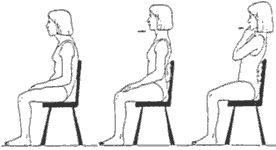
With more and more people now working from home, and no longer having access to ergonomic workstations that they would typically have when working in a big office, it can make us more susceptible to develop aches and pains. Home office ergonomics isn’t as easy to control as it is in a big office setting.
First let’s start with what is ergonomics in the workplace? It is the science of designing the workplace while keeping in mind the capabilities and limitations of the worker. When we improve the workplace ergonomics, it reduces the risk factors that lead to musculoskeletal injuries and allows for improved performance and productivity. Many large office environments will have a team in place to perform ergonomic assessments for staff members and invest in modifying the workspace to help the employees.
But what happens when we can no longer work from this well designed work station? How do we deal with working on a different device when we must work from home? Is there a way to change our home office ergonomics?
There are 2 approaches that we can take to this dilemma and improve our home office ergonomics:
- Make our own modifications depending on the type of equipment you use
- Be more proactive about small exercises to minimize the impact of bad postures
Home Office Ergonomics Tip #1 – Make Modifications Based on Device Used
Whether you are using a laptop computer, tablet or even responding to e-mails with your smartphone, we need to be vigilant with certain elements of our posture. Home office ergonomics can be maintained with a few small changes.

Laptop & Tablets
Laptop computers have the advantage of being portable which allows us to work on the move, or even away from the office altogether. However, a big disadvantage of a laptop computer is it’s fixed design. If the keyboard is in an optimal position for the user, the screen isn’t and if the screen is optimal the keyboard isn’t. This causes a flexed forward position of the neck which often leads to neck pain. To make a laptop computer as ergonomic as possible without breaking the bank, get an external keyboard that can be connected via USB or Bluetooth. This now forces the keyboard to be in a fixed position.
Once the keyboard is fixed we can now use the laptop as a monitor and place something underneath it to elevate it to the right height. What is the right height you might ask? Ensure that the first line that you are reading is at the same level as your eyes, that way you can glance down the screen with your eyes, rather than flex your neck down. This way, we can work with a straight neck position. The same information applies to the use of a tablet, the best plan is to get an external keyboard and use the tablet merely as a monitor. The tablet can be raised by yoga blocks, shoe box, thick books, etc.

Smartphone
When it comes to using a smartphone to respond to quick messages, ideally you want to elevate the device to minimize how much the neck is bent forward. It is not ideal to be working any significant time on a device such as a smartphone, therefore not ideal for home office ergonomics.
Home Office Ergonomics Tip #2 – Being Proactive with Exercises to Minimize Impact of Posture
The common bad postures that we adopt when not working in an ergonomically correct setting are forward neck posture and shoulders rolled forward. Consistent postures like this can start to cause neck, upper back and shoulder pain, as well as headaches. How can we minimize the development of these bad postures and improve our home office ergonomics? By strengthening the muscles that are designed to hold the body straight, it can go a long way in preventing us to get in these postures. Incorporating these stretches can assist in our home office ergonomics plan.
Tuck in the Chin
One of the simplest exercises to minimize the forward head posture is to tuck in the chin. This exercise allows us to strengthen the muscles in the front of the neck while stretching the muscles at the back, which are at the base of the skull. It’s also giving the body the impression of what ideal posture is. Because this muscle is a postural muscle, we want to build some endurance into it, so when we are doing the exercise we should hold it about 5-10 seconds each time and do about 10-15 repetitions. Doing this at various times throughout the day is ideal.

Shoulders Back
One way to avoid having our shoulders roll forward is to strengthen the muscles between the shoulder blades. When we do this movement it automatically straightens up our posture, which decreases the forward head posture as well. By doing this several times per day, repeated 10-15 times and holding 5-10 seconds each time, it is similar to the exercise above, as it gives the body an idea of ideal posture and builds endurance in the muscles.

Head side to side
It is very common to see people hike up their shoulders, sometimes it is associated to stress, sometimes it is due to posture. At the end of the day we just feel tension in our necks and shoulders. One way to combat that is by stretching your neck from side to side. This can be done several times per day, we hold it a little bit longer to get a nice stretch (15-20 seconds) but only repeat it 3 to 5 times.

What do you find challenging from an ergonomic perspective when working from home? If you have any questions about home office ergonomics, let them in the comments section.







